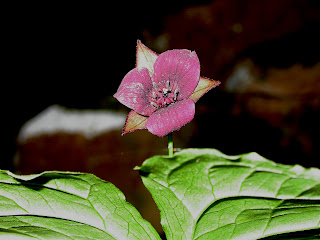As many of you know, last week, Justin Thomas and I embarked on a trip known as Trillium Tromp 2009. We spent time in Tennessee, Alabama, and Georgia, logging three species of
Trillium new to both of us. We had hoped to find six or seven species, but were also focused on seeing a variety of species and habitats (some of which knowingly would not have
Trillium). I will post about other plants we observed in future posts, but for now, I wanted to briefly discuss the three species of
Trillium that we saw.
Trillium catesbaei, a true
Trillium (in the subgenus
Trillium)
, was to me the most graceful
Trillium of the trip. We found it growing in moist acidic woods, as well as in the grassy, somewhat shrubby area near our campsite at DeSoto State Park in Alabama. As the name implies, this trillium was named in honor of English naturalist Mark Catesby. This is one of the trillies with a pedicel that nods, leading to flowers held below the bracts. According to Case and Case, there is a form of this species that grows in South Carolina with an erect pedicel. The stigmas, unlike those of the somewhat similar
Trillium cernuum and
Trillium flexipes, are uniformly thin throughout, although they are connected basally into a short style. The petals are curved backwards and range in color from white to pink.

Trillium cuneatum is an extremely variable species, with petal color ranging from maroon to purple to brown to green to yellow, and to all colors in between. Petals are sometimes even bicolored. We saw most of these color variants at Old Stone Fort State Park in Tennessee and at Cloudland Canyon State Park in Georgia. The specific epithet comes from the shape of the petals, which are wedge-shaped at the base and broad above. This trillium was observed in upland woods; it is known to occur in both sandstone- and limestone-based soils. Unlike the species above and below, the flowers of Trillium cuneatum are sessile. This is one big trillie, growing to up to 45 cm tall, with petals sometimes longer than 6 cm. The stigmas of this species are separate to the base, putting it in the subgenus Phyllantherum. Unlike Trillium recurvatum, the sepals are horizontally spreading to erect. Trillium cuneatum may be confused with Trillium sessile, but the anther dehiscense is latrorse in the former and introrse in the latter. Finally, the connectives of the stamens of Trillium cuneatum are barely prolonged beyond the anthers, and the leaves come to an abrupt point.
 Trillium sulcatum
Trillium sulcatum was the least common of the three trilliums that we observed. We found it only in a couple of spots in acidic, mesic forest at Cloudland Canyon State Park in Georgia, where it is at the edge of its range. Like
Trillium catesbaei,
Trillium sulcatum is in the subgenus
Trillium; however, the flowers are on pedicels held above the bracts. The specific epithet comes from the boat-shaped tips of the sepals. The stigmas are thickened basally, and the ovaries are large and six-angled.
Trillium sulcatum has petals that are wider than the sepals, and leaves that are very wide. This species is similar to
Trillium erectum, and has been treated as a variety of
T. erectum by some authors; however, according to Case and Case,
Trillium sulcatum generally is taller, larger-leaved, and more robust than
Trillium erectum. Also, the flowers of
Trillium sulcatum face outward at a 90 degree angle from the erect pedicel, a feature not seen in
Trillium erectum.

A few additional photos of these trilliums can be found
here.
After this trip, I consider myself a true trilloholic.
Information from this post from:
Case, Frederick W., Jr. and Roberta B. Case. 1997. Trilliums. Timber Press, Inc., Portland, Oregon.
 Tony and I spent a good part of the day botanizing grassed swales in northwest Indiana (not too exciting), so I decided to post a few photos of this gorgeous Rosaceous plant, which is growing in my home landscaping. Geum triflorum isn't found naturally in Indiana, but it is known from prairies in Illinois, Wisconsin, and Michigan (threatened), as well from much of Canada and the western United States. The only place I have ever seen this plant growing naturally was on a remnant hill prairie in Wisconsin. I'm typically a purist when it comes to native landscaping, but this is just a cool plant.
Tony and I spent a good part of the day botanizing grassed swales in northwest Indiana (not too exciting), so I decided to post a few photos of this gorgeous Rosaceous plant, which is growing in my home landscaping. Geum triflorum isn't found naturally in Indiana, but it is known from prairies in Illinois, Wisconsin, and Michigan (threatened), as well from much of Canada and the western United States. The only place I have ever seen this plant growing naturally was on a remnant hill prairie in Wisconsin. I'm typically a purist when it comes to native landscaping, but this is just a cool plant. As you can see in the close-up, the "smoke" or "old man's whiskers" are actually mature, plumose styles visible when the plant is in fruit. (As a side note, nature is full of plumose, or feathery, structures... to see another click here.) These feathery styles are important for seed dispersal in this species. The nodding flowers aren't very showy, as they consist of 3/4" pinkish sepals surrounding white or light pink petals that never seem fully open.
As you can see in the close-up, the "smoke" or "old man's whiskers" are actually mature, plumose styles visible when the plant is in fruit. (As a side note, nature is full of plumose, or feathery, structures... to see another click here.) These feathery styles are important for seed dispersal in this species. The nodding flowers aren't very showy, as they consist of 3/4" pinkish sepals surrounding white or light pink petals that never seem fully open.
































